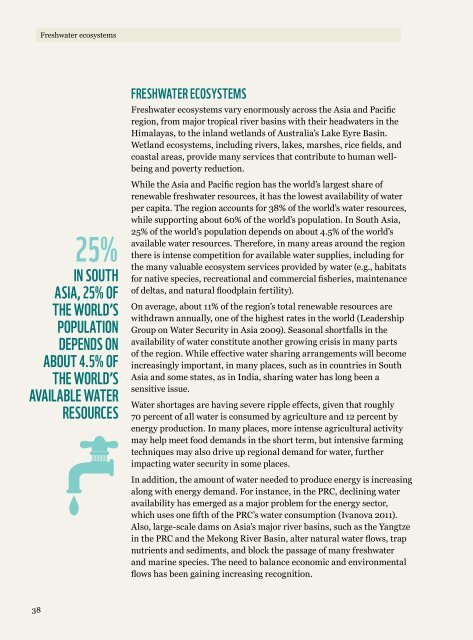Download the pdf - Global Footprint Network
Download the pdf - Global Footprint Network
Download the pdf - Global Footprint Network
Create successful ePaper yourself
Turn your PDF publications into a flip-book with our unique Google optimized e-Paper software.
38<br />
Freshwater ecosystems<br />
25%<br />
In south<br />
AsIA, 25% oF<br />
<strong>the</strong> WoRLD’s<br />
PoPuLAtIon<br />
DePenDs on<br />
ABout 4.5% oF<br />
<strong>the</strong> WoRLD’s<br />
AvAILABLe WAteR<br />
ResouRCes<br />
FReshWAteR eCosYsteMs<br />
Freshwater ecosystems vary enormously across <strong>the</strong> Asia and Pacific<br />
region, from major tropical river basins with <strong>the</strong>ir headwaters in <strong>the</strong><br />
Himalayas, to <strong>the</strong> inland wetlands of Australia’s Lake Eyre Basin.<br />
Wetland ecosystems, including rivers, lakes, marshes, rice fields, and<br />
coastal areas, provide many services that contribute to human wellbeing<br />
and poverty reduction.<br />
While <strong>the</strong> Asia and Pacific region has <strong>the</strong> world’s largest share of<br />
renewable freshwater resources, it has <strong>the</strong> lowest availability of water<br />
per capita. The region accounts for 38% of <strong>the</strong> world’s water resources,<br />
while supporting about 60% of <strong>the</strong> world’s population. In South Asia,<br />
25% of <strong>the</strong> world’s population depends on about 4.5% of <strong>the</strong> world’s<br />
available water resources. Therefore, in many areas around <strong>the</strong> region<br />
<strong>the</strong>re is intense competition for available water supplies, including for<br />
<strong>the</strong> many valuable ecosystem services provided by water (e.g., habitats<br />
for native species, recreational and commercial fisheries, maintenance<br />
of deltas, and natural floodplain fertility).<br />
On average, about 11% of <strong>the</strong> region’s total renewable resources are<br />
withdrawn annually, one of <strong>the</strong> highest rates in <strong>the</strong> world (Leadership<br />
Group on Water Security in Asia 2009). Seasonal shortfalls in <strong>the</strong><br />
availability of water constitute ano<strong>the</strong>r growing crisis in many parts<br />
of <strong>the</strong> region. While effective water sharing arrangements will become<br />
increasingly important, in many places, such as in countries in South<br />
Asia and some states, as in India, sharing water has long been a<br />
sensitive issue.<br />
Water shortages are having severe ripple effects, given that roughly<br />
70 percent of all water is consumed by agriculture and 12 percent by<br />
energy production. In many places, more intense agricultural activity<br />
may help meet food demands in <strong>the</strong> short term, but intensive farming<br />
techniques may also drive up regional demand for water, fur<strong>the</strong>r<br />
impacting water security in some places.<br />
In addition, <strong>the</strong> amount of water needed to produce energy is increasing<br />
along with energy demand. For instance, in <strong>the</strong> PRC, declining water<br />
availability has emerged as a major problem for <strong>the</strong> energy sector,<br />
which uses one fifth of <strong>the</strong> PRC’s water consumption (Ivanova 2011).<br />
Also, large-scale dams on Asia’s major river basins, such as <strong>the</strong> Yangtze<br />
in <strong>the</strong> PRC and <strong>the</strong> Mekong River Basin, alter natural water flows, trap<br />
nutrients and sediments, and block <strong>the</strong> passage of many freshwater<br />
and marine species. The need to balance economic and environmental<br />
flows has been gaining increasing recognition.

















